Introduction
Now that the Kamala Harris campaign has had a two-week run (although without a running mate), the Biden re-election campaign is now in the past tense, thus making it important for the Trump/Vance ticket to recalibrate its approach, now that it has a different opponent.
While the Olympics are still front and center until August 11, and the Democratic convention in Chicago doesn’t convene until August 19, what has happened (from a polling perspective) to the Presidential race? Before discussing the Presidential race, it’s important to reiterate that 18 states have not yet held their primaries for Congressional, state, legislative, and local races. Four states (Kansas, Michigan, Missouri, and Washington) are holding their primaries on Tuesday, while Hawaii’s primary is next Saturday. This “primary-a-thon” will last until September 10 (Louisiana’s primary coincides with the Federal Election Day of November 5).
Presidential polling
When discussing polling for the 2024 Presidential contest, there are two atmospheric challenges the party in power/its apparent nominee Kamala Harris faces: (1) underwater approval ratings for her (while her 42-49% approval/disapproval according to 538 is an improvement on last week’s 38-52% approval/disapproval number, she is still “underwater”), and (2) persistent high disapproval (42-55% approval/disapproval according to a 7 day average of polls taken) for the Biden administration. Since Kamala Harris is still Joe Biden’s Vice-President, that persistent disapproval is something she will have as a drag on her campaign.
Still, the Harris campaign has benefitted from two weeks of a smoothly executed rollout of her campaign, while at the same time, the Trump/Vance ticket has dealt with seemingly daily blunders/controversies coming from either member of the ticket. It’s a combination of this that has moved the polls in Kamala Harris’ direction for two weeks in a row.
While it’s important not to overstate the change in the political climate (a 3.2% Trump poll lead two weeks ago is still 1% in his favor), campaign momentum is something that should not ever be ignored. Because if current trends were to continue, Harris would be up a point in the national polls by the time the Democrats convene in Chicago on August 19, and since convention news coverage that week likely will give the Democrats another “good week”, Donald Trump can ill afford further erosion in his lead as Labor Day (the traditional kickoff for the final sprint) gets ever closer. Below is a representation of the weekly changes in the national poll averages:
It’s also important (in terms of putting the poll numbers in their proper context) to realize that the Electoral College (and not the national popular vote) is what actually elects a President, and that presently benefits the Republicans. Since there is an inefficient vote distribution of Democratic and Republican votes, it’s possible for a Republican to be elected President without attaining a popular vote majority (or even a plurality), because California and New York have in recent election cycles generated larger Democratic vote margins than Florida and Texas have for Republicans.
National popular vote vs the Electoral College
Even though Joe Biden was elected in 2020 with a 4.5% popular vote margin (51.3-46.8% over Donald Trump) and a 303-235 lead in the Electoral College using applicable numbers for the 2024 Presidential election (270 electoral votes are needed to win), Biden’s Electoral College victory due to narrow victories in several states, like Arizona, Georgia, Michigan, Nevada, Pennsylvania, and Wisconsin.
From that baseline of a 4.5% national popular vote win, we can assess the extent to which shifts in the national popular vote could flip specific states, as national shifts do have an impact in both swing and non-swing states. To be conservative in his analysis, JMC is assuming that only half of a national popular vote shift (percentage-wise) would occur in a swing state, since those states (which get an oversized amount of attention from either side) tend to be less elastic in their movement towards a candidate.
Even with this conservative analysis, any movement towards Trump relative to a 4.5% national popular vote deficit would still have an electoral impact in that states that voted for Biden in 2020 would “flip” to Trump this time around. For example, even a Kamala Harris national popular vote win of 3.5% (a shift of 1% towards Trump, in other words) would flip Arizona and Georgia, which would then put Trump up to 262 electoral votes (8 electoral votes shy of a victory, in other words), while a Harris win of 2.5% (a 2% shift towards Trump relative to 2020) would also flip Wisconsin and get Trump to the necessary 270 electoral votes.
The last seven days of national polling (even with Harris narrowing the margin for two weeks in a row) shows an average poll lead for Trump of 1.0% (he’s up 47.2-46.2% over Harris), which would translate to 297 electoral votes for Trump. In other words, a 1.0% Trump lead means that there was a 5.5% swing to Trump relative to his 2020 popular vote loss, and a swing of that magnitude (even accounting for swing states’ being less elastic than the rest of the country) would flip Arizona, Georgia, Nevada, Pennsylvania, and Wisconsin. Below is a representation of the electoral college impact of various national popular vote possibilities.
Conclusion
Even though the last two weeks have not been good for Republicans, Kamala Harris still trails President Trump, and at some point, the focus will shift to Republicans’ defining Harris’ record/past statements, and that will have some sort of electoral impact. What is crucial for Republicans is to define her while avoiding making controversial remarks that turn off swing voters, because further erosion in their lead will cause the national popular vote to “go into the blue”, and “going into the blue” nationally will cause swing states to return to the Democrats. This posting was meant as a visual illustration of how national polling numbers would translate to various Electoral College vote possibilities.



